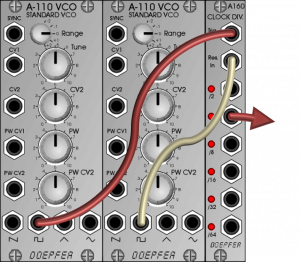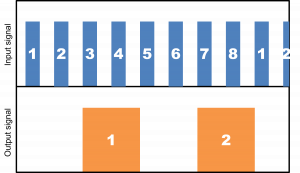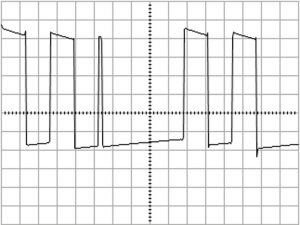The A-160-1 Clock Divider can generate slower variants (e.g. half as fast, 1/4 as fast, etc.) from a periodic trigger signal (a “clock signal”). The A-160-1 is often supplemented with the A-161 Clock Sequencer, which requires the A-160-1 as a necessary basic module.
But the A-160-1 can of course also be used as an audio frequency divider and offers sub-oscillator signals up to 6 octaves below the input signal. In contrast to e.g. the A-115 Audio Divider, with the A-160-1 you still have to match the sub-octaves with a mixer in terms of volume.
User interface
Inputs:
EN-CTRL-A160-1-INOutputs:
EN-CTRL-A160-1-OUTDivision of clock signals
This is actually the “standard” for the A-160-1: we use a periodically clocked square-wave signal, which can then be divided into half the speed, a quarter, and so on. This can then be used to clock a second A-155, which, for example, should only switch every fourth step.
And that’s exactly where a small problem is hidden, which is based on the special type of frequency division. Let’s take the 1/2 division as an example. The A-160-1 “counts” the triggers on the input and as soon as the second trigger is registered, it sends a trigger itself. Problem solved, the frequency is halved.
It works absolutely exactly, but unfortunately it’s not what we consider “musical”. The split trigger would always have to be on the first beat and not, for example, on the second eighth of a bar. Interesting music can still be made with it, it’s just going to be a little different than what we might expect.
With higher division factors, things get even weirder. The reason is that the clock divider always splits a given number of input triggers into two exactly equal parts and starts its output trigger at exactly halfway. That sounds logical at first, but with 1/4 you get a split where the output trigger starts at the THIRD input trigger, at 1/8 the output trigger starts at the FIFTH input trigger, etc.
This can be remedied by inverting the divided triggers, so with a 1/2 division we get a trigger signal on 1, 3, 5 etc. and with a 1/4 division on 1, 5 etc.
Suboscillator
In addition to its “genuine” use as a clock divider for sequencer patches, the A-160-1 can also be used very well as an audio suboscillator. Due to its narrow design of only 4 TE, this is particularly interesting for smaller (or already quite full) systems.
The reset input can be used to create unusual sync-like sounds with the help of a second oscillator.

Sound examples
The sound example corresponds to the patch just described: The square-wave signal of an A-110-1 VCO is used as the input signal, the square-wave signal of a second A-110-1 transposed 2 octaves down as a reset trigger. The “/4” output (2nd suboctave) is used from the A-160-1. We start with a reset VCO that is detuned significantly downwards (Tune =0), I slowly increase the Tune control to 10 and then much faster back to 0.
Alternatives
In addition to the very handy A-160-1 in the audio range, the A-115 Audio Divider with its four sub-octaves generated in parallel, the voltage-controlled A-163 VC Frequency Divider and the programmable A-113 Trautonium Subharmonic Generator can of course also be used as frequency dividers.
The A-160-2 Clock/Trigger Divider II, on the other hand, is more specialized in clock signals, which, in addition to a wealth of output and divider options, also solves the problem of clock division described above in a different way and thus saves the downstream trigger inverter: Here the divided clock is actually always output on the first beat.
Technical specifications
| Width | 4 HP |
| Depth | 40 mm |
| Power requirements | 40 mA (+12V) / -0 mA (-12V) |



